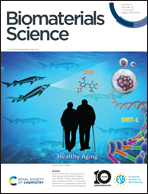Recent advances in Prussian blue-based photothermal therapy in cancer treatment
Abstract
Malignant tumours are a serious threat to human health. Traditional chemotherapy has achieved breakthrough improvements but also has significant detrimental effects, such as the development of drug resistance, immunosuppression, and even systemic toxicity. Photothermal therapy (PTT) is an emerging cancer therapy. Under light irradiation, the phototherapeutic agent converts optical energy into thermal energy and induces the hyperthermic death of target cells. To date, numerous photothermal agents have been developed. Prussian blue (PB) nanoparticles are among the most promising photothermal agents due to their excellent physicochemical properties, including photoacoustic and magnetic resonance imaging properties, photothermal conversion performance, and enzyme-like activity. By the construction of suitably designed PB-based nanotherapeutics, enhanced photothermal performance, targeting ability, multimodal therapy, and imaging-guided cancer therapy can be effectively and feasibly achieved. In this review, the recent advances in PB-based photothermal combinatorial therapy and imaging-guided cancer therapy are comprehensively summarized. Finally, the potential obstacles of future research and clinical translation are discussed.



 Please wait while we load your content...
Please wait while we load your content...